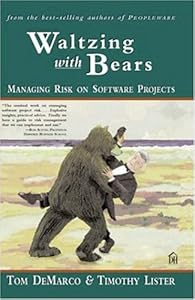
Reflection on Chapters 14 to 17 of Waltzing with Bears : Managing Risk on Software Projects by Tom Demarco
Link to sample Chapter 1 from Waltzing with Bears http://www.systemsguild.com/pdfs/bearsample.pdf
Link to Waltzing with Bears Textbook Download
Link to Waltzing with Bears Textbook Download
Chapter 14, “A Defined process for
Risk discovery”, states that along with core risks, there may be project-specific
risks that impact a project. This chapter talks about identifying
project-specific risks and the factors that hinder the risk discovery process.
One such factor is the “can-do” attitude of the organization, wherein a project
member who articulates a risk could be termed as a negative-thinker. In order
to overcome this problem, it is important that the organization encourages
“what-if” thinking. This is also the basis of the defined process for risk
discovery described which begins with the outcomes of the risk, unfolding the
scenarios that could lead to the risk and ultimately the causes of the scenarios.
The chapter
also suggests some more techniques for risk discovery such as brainstorming,
scenario-building and root cause analysis. My previous project employed the
brainstorming and root-cause analysis techniques for identifying the causes of
defects in the code, which were very effective in reducing majority of the defects
caused due to oversight or not following coding standards. These techniques
will help promote “what-if” thinking among project members to identify the
risks. The author also recommends identifying and isolating the “win”
conditions of each stakeholder in the project to make sure that they are not
contradictory, as conflicts in “win” conditions is a definite risk to the
project being accepted.
Chapter 15, “Risk Management
Dynamics” emphasizes the importance of risk management as an ongoing activity
as opposed to an activity done only at the beginning of the project. It
includes the following tasks that need to be carried out throughout the life
cycle of the project - risk monitoring, risk discovery, risk data collection
and tracking closure metrics. The closure metrics that need to be tracked
include “boundary elements closure” and “earned value running”. The boundary
elements closure metric protects against the risk of specification breakdown by
analyzing the net boundary flows so as to obtain a sign-off by all the
stakeholders within the first 15% of project duration. The earned value running
(EVR) metric is used to track project completion status from 0 to 100 percent
and provide credible evidence of partial doneness while the project is in
progress, as and when each module of the project completes (incremental
delivery).
Chapter 16, “Incrementalism for Risk
Mitigation” further explains the concept of “incremental implementation” as
explained by the earned value running metric collection in the previous
chapter. Creating the work breakdown structure is one of the techniques for
categorizing tasks and their dependencies, measuring the EVR and targeting
incremental delivery. In my previous project, the visual basic screens for
insurance member enrollment and billing were developed in increments and each
week a “build” (incremental version) of all the screens combined would be sent
to the client as a deliverable for review. This technique would help in increasing
visibility and involvement of the stakeholders and gaining acceptance from them
early on as the product is being developed as opposed to once the product is
already built and thereby, reduces the risk of product not being accepted by
the stakeholders. It also helps in targeting the uncertain requirements in
earlier versions to reduce the risk. So, I agree with the author that
incremental delivery is a good method for any project, especially when the
risks are high.
Chapter 17, “The Ultimate risk
mitigation strategy” emphasizes with examples that for projects with critical
deadlines, it is better to make an early start, which I think is a very
practical option for reducing the risk of not meeting deadlines. It will also
help in discovering issues early on. Since the amount of effort involved in a
project is more or less constant, starting the project early will enable
finishing it early or at least on time.
Thanks a lot for that information. That was really helpful post.
ReplyDelete